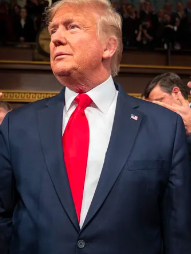As Trump steps back from the campaign trail, a battle is brewing over his massive donor network.
What to Know:
- JD Vance has emerged as the leading contender for Trump’s donor network, backed by both high-dollar contributors and grassroots MAGA supporters.
- Donald Trump Jr. is emerging as a potential MAGA successor, leveraging his deep ties to conservative media and grassroots donors to keep the movement alive.
- DeSantis faces an uphill battle after his failed 2024 campaign, with the 2026 midterms as his key opportunity to regain credibility.
- Trump’s PACs, including Save America and MAGA Inc., still dominate GOP fundraising, controlling key donor lists and resources.
- Whoever secures Trump’s donor base won’t just win financially—they’ll inherit his movement and shape the future of the Republican Party.
Donald Trump may be stepping away from future presidential campaigns, but his fundraising empire remains one of the most formidable forces in American politics. After nearly a decade of leveraging small-dollar donations, digital outreach, and grassroots enthusiasm, Trump built a donor network that shattered Republican fundraising records. Now, as the Republican Party looks beyond Trump, a critical question arises: Who will inherit his donors?
Who Benefits Most?
According to Campaigns & Elections, Republican strategists see Trump’s exit as an opportunity.
“President Trump is the most prolific fundraiser the Republican Party has ever seen,” said Matt Kahn, VP of fundraising at GOP firm TLC Political. “The team he’s assembled is incredible, but there is a large donor base that isn’t going to be mass-marketed to as much. That gives other [candidates] the opportunity to acquire that donor base.”
For nearly a decade, Donald Trump’s ability to command a fiercely loyal donor base reshaped Republican fundraising. From small-dollar contributors sending in $5 at a time to deep-pocketed billionaires cutting multimillion-dollar checks, Trump created a fundraising juggernaut unlike anything seen before in GOP politics. His digital-first strategy, emotional appeals, and relentless engagement kept cash flowing—even during his legal battles, impeachment fights, and post-presidency ventures.
But, in 2028, with Trump no longer at the top of the ticket, the question isn’t just who will run in 2028—it’s who will inherit his donors. The financial network that fueled three presidential campaigns and countless down-ballot races is now adrift, and several rising Republican figures are already maneuvering to claim a piece of the empire.
Raising money is not the only goal for GOP candidates aiming for 2028; they also need to demonstrate that they can continue the MAGA movement. Trump’s donor list represents more than just a revenue stream; it’s a stamp of approval, a direct line to the party’s most passionate grassroots supporters. In addition to being well-funded, the candidate who wins over Trump's supporters is in a position to take over his movement.
So far, three key players are emerging as the most likely heirs to Trump’s financial army: Ohio Sen. JD Vance, Donald Trump Jr., Florida Gov. Ron DeSantis, and Trump’s own PACs, which may continue to control fundraising even without a presidential run. Each contender has a different strategy and appeal, but only one will win the war for the MAGA money machine.
Is JD Vance the Apparent Heir of MAGA?
Among those best positioned to inherit Trump’s political and financial legacy is Ohio Sen. JD Vance. His journey from a self-proclaimed Never-Trumper to one of the former president’s most vocal allies has been nothing short of remarkable. Once skeptical of Trump’s rise, Vance has since fully embraced the populist-nationalist movement, positioning himself as a natural successor to the America First agenda.
JD Vance; Source: White House Website
Vance’s 2022 Senate campaign served as a proving ground for his fundraising capabilities. With Trump’s full endorsement and major backing from billionaire Peter Thiel, he raked in tens of millions in donations, demonstrating his ability to mobilize both high-dollar donors and grassroots supporters. His appeal lies in his anti-elitist rhetoric, his emphasis on economic nationalism, and his willingness to take on the establishment—both Democratic and Republican.
Looking ahead, Vance’s ability to retain Trump’s small-dollar donor army will depend on his commitment to the core issues that defined the MAGA movement:
- Border security and opposition to illegal immigration
- Trade protectionism and America First economic policies
- A hardline stance against the political elite and corporate influence
- Cultural conservatism focused on combating what he calls “woke” institutions
His Senate tenure has already proven his ability to attract Trump-aligned donors, and if he maintains his firebrand messaging, he could emerge as the strongest contender to absorb Trump’s financial empire.
Is Donald Trump Jr. the Next MAGA Successor?
Another name circulating in places like the Washington Post as a potential heir to Trump’s political and financial machine is Donald Trump Jr. As one of his father’s most aggressive and loyal defenders, Trump Jr. has spent years building his brand within the MAGA movement. His fiery rhetoric, deep connections with conservative media, and relentless attacks on the political establishment have made him a favorite among Trump’s grassroots supporters.

Donald Trump Jr.; Source: Wikimedia
Trump Jr. has played a key behind-the-scenes role in shaping Republican messaging and mobilizing the America First donor network. His media presence on platforms like Rumble, his frequent appearances at MAGA rallies, and his strong ties to Trump-aligned Super PACs position him as a natural choice to take up his father’s mantle. Unlike other contenders, he doesn’t have to prove his loyalty—his last name alone ensures he is firmly embedded in Trump-world.
If Trump Jr. is serious about inheriting his father’s donor base, his success will hinge on his ability to:
- Maintain Trump’s small-dollar grassroots fundraising model
- Appeal to the establishment GOP donors who previously backed his father
- Continue dominating conservative media spaces to keep the MAGA base engaged
- Distance himself from other 2028 contenders like JD Vance and Ron DeSantis
Despite speculation, Trump Sr. has not publicly anointed his son as his political successor. However, if Trump Jr. chooses to step into a larger leadership role within the movement, his built-in name recognition and deep ties to MAGA donors could make him one of the most formidable contenders in the post-Trump era.
Does Ron DeSantis Have a Second Chance at MAGA?
Just a few years ago, Florida Gov. Ron DeSantis was seen as the heir apparent to Trump’s movement—a younger, battle-tested leader who could carry the MAGA torch into the next decade. His 2024 presidential bid, however, was a disaster. Despite strong early momentum and backing from major GOP donors, his campaign failed to resonate with Trump’s grassroots base, leading to a rapid decline in support and fundraising struggles.
Ron DeSantis; Source: WikiMedia
Much of DeSantis’s downfall stemmed from his positioning as Trump’s direct competitor in 2024. Instead of inheriting the movement, he found himself locked in a bitter primary battle where many Trump loyalists viewed him as an opportunistic rival rather than a true successor. His strained relationship with Trump cost him key grassroots donors, many of whom refused to back him—even if they supported his policies.
However, DeSantis is far from politically finished. High-dollar Republican donors and the policy-driven conservative establishment still see value in his leadership. He maintains strong ties to influential GOP figures, corporate donors, and major SuperPACs, making him a powerful force within the party’s financial machine.
To regain traction, DeSantis must:
- Regain trust with Trump’s base after his 2024 primary struggles.
- The 2026 midterms will be a critical test of his ability to reestablish credibility.
- A Trump endorsement before 2028 could revive his standing and donor support.
Without Trump’s backing, he faces an uncertain future against rising contenders.
Trump-Aligned PACs and the Shadow Influence of His Network
Donald Trump may be stepping away from the presidential campaign stage, but his financial influence within the Republican Party is far from over. His Save America PAC and MAGA Inc. Super PAC continue to control massive war chests, ensuring that Trump’s brand remains the dominant force in GOP fundraising.
|
These Trump-aligned PACs serve two key functions:
|
|
Trump-Backing PACs & Super PACs
|
The GOP’s New Fundraising Playbook: Digital Domination
One of the most important lessons from Donald Trump’s rise is the power of small-dollar digital fundraising. Unlike past Republican nominees who relied on deep-pocketed donors and corporate PACs, Trump built a grassroots financial empire through a relentless digital strategy. His campaign mastered the use of SMS marketing, email blasts, and peer-to-peer texting, transforming everyday supporters into repeat donors who contributed in small amounts but at massive volume.
This approach reshaped Republican fundraising, allowing Trump to compete financially with Democrats despite efforts by major corporations and elite donors to distance themselves from his brand. His ability to turn outrage into fundraising gold—whether through attacks on the media, threats from political opponents, or policy fights—created a constant stream of contributions from supporters who viewed their donations as part of the larger political battle.
Now, as the GOP looks ahead to the post-Trump era, future candidates will need to adopt and refine his digital-first strategy to tap into his donor base. Matt Kahn, VP of fundraising at TLC Political, explained the evolving approach:
“Each channel can help inform the strategy in the others. You’re gonna find unique opportunities to see that, ‘Hey, this email donor responds really well to direct mail, or this direct mail donor really responds well to text messages.’”
The key to this strategy is engagement. Trump’s campaign didn’t just ask for donations—it built a relationship with donors, making them feel like active participants in a movement. Text messages felt urgent, emails sounded personal, and social media posts turned fundraising into a shared fight against political enemies.
Wrap Up
As the GOP looks ahead to 2026 and beyond, the fight for Trump’s massive donor base is already shaping the party’s future. The midterms will serve as the first major test, with Trump-endorsed Senate and House candidates expected to dominate small-dollar fundraising. But the real battle is happening behind the scenes, as potential 2028 contenders like JD Vance and Ron DeSantis quietly position themselves, building national networks, expanding donor lists, and seeking the endorsements that will define the next Republican frontrunner.
Trump remains the gravitational force of Republican fundraising, controlling endorsements, PACs, and a digital-first donor empire that no candidate can afford to ignore. Whether he anoints a political heir or keeps his influence firmly intact, his financial footprint will dictate the party’s trajectory.
If one contender successfully consolidates MAGA support, they could inherit Trump’s small-dollar machine, emerging as the dominant force in 2028 and beyond. But if Trump remains deeply involved, donors may wait for his explicit blessing, delaying the rise of a new GOP leader.
Either way, the battle for Trump’s donor machine is already underway—and the winner may ultimately shape the future of Republican politics for a generation.



.png)

.jpg)